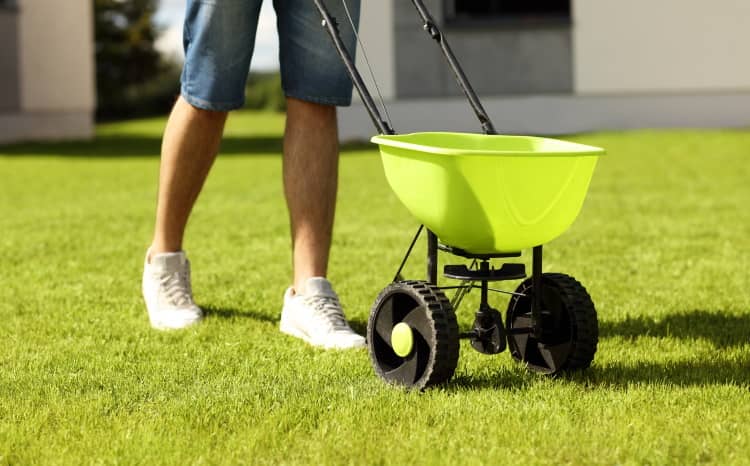Applying a pre-emergent herbicide is an important step in keeping your yard weed-free. But for pre-emergent weed control to work, you need to get the timing right.
So in this article, I’ll show you how they work, how and when to use them on different types of weeds, and how to select the right pre-emergent herbicide to get the best results.
Let’s dive in!
What Is Pre-Emergent Weed Control?
The purpose of pre-emergent weed control is to prevent weed seeds from sprouting after germination.
Weeds that spread by seed can be hard to control. You can kill the weeds growing in your yard. But if seed dispersal has already occurred, they will reappear in the next growing season.
When you apply a pre-emergent herbicide to the soil you can prevent the weed seeds from sprouting. This stops the weeds from taking over your yard and reduces the amount of weeding you have to do each year.
It’s important to realize that unlike other types of weed killers, pre-emergent herbicides don’t kill weeds that are currently growing in your yard. They only prevent new weeds from developing.
And they won’t control perennial weeds that grow back each year from thick adult roots. They are only used to prevent annual weeds.
How Do Pre-Emergent Herbicides Work?
When you apply a pre-emergent herbicide, it creates a protective barrier of chemicals in the soil. These chemicals prevent the weed seeds from producing the enzymes and undergoing the cell division required for a seedling to sprout.
The pre-emergent chemicals inhibit the development of roots and shoots. Killing the weed before it has a chance to grow through the topsoil and become visible.
Because pre-emergent herbicide doesn’t kill the weed seeds, they can remain dormant in the soil. And can germinate and sprout in the following years. This makes weed control a constant process. So to prevent an outbreak of weeds with seeds, you should apply the pre-emergent herbicide each year.
When to Apply Pre-Emergent Weed Control
The most effective times to apply pre-emergent herbicides to the ground are early spring and the fall. This is when the majority of weeds germinate. But you can use pre-emergent weed control throughout the year to deal with weed species that continue to sprout.
If you apply a pre-emergent herbicide in the spring, you’ll be targeting different weeds than if you apply it in the fall. So it’s a good idea to identify the type of weeds growing in your garden. Then you can use the pre-emergent herbicide at the right time of year.
Spring
To prevent summer annual weeds you should apply a pre-emergent herbicide in the spring.
The best practice is to apply the pre-emergent herbicide a couple of weeks before seed germination. But make sure you use it no later than 36 to 72 hours before germination to get good results.
To identify the right time to use it, wait until the soil temperature reaches about 55° Fahrenheit for several days. Test about 4-inches deep. In most parts of the United States, the soil reaches this temperature somewhere between March and April.
Examples of summer annual broadleaf weeds include:
- Spurge
- Carpet weed
- Black magic
- Ragweed
- Clover
- Knotweed
Examples of summer annual grassy weeds include:
- Crabgrass
- Sandpaper
- Goosegrass
- Foxtail
- Barnyard grass
Fall
To prevent winter annual weeds you need to apply the pre-emergent herbicide somewhere around late summer to early fall. But it varies depending on your location.
Wait for the soil temperature to drop to 70°F before applying the pre-emergent herbicide to the soil. You can use a soil thermometer to keep track of the soil temperature until it cools enough.
Another way of judging it is to wait until daytime temperatures drop to the mid-70s for 3-5 consecutive days.
Examples of winter annual weeds include:
- Chickweed
- Henbit
- Deadnettle
- Annual bluegrass (Poa annua)
Some weeds are difficult to control. And you may need to apply the pre-emergent herbicide multiple times across several seasons to get a level of control that you’re happy with.
How to Apply Pre-Emergent Weed Control
For the best results, make sure you do the following:
Mix The Pre-emergent Correctly
For the pre-emergent to work, you need to mix it to the right strength. Follow the instructions that come with the product and calibrate your sprayer if necessary.
Apply The Pre-emergent Evenly
Even and thorough coverage of the area is the key to making sure that few weeds manage to sprout and grow. Spot spraying is ineffective.
Water The Pre-emergent Into The Soil
Water activates the herbicide. And the chemicals are washed into the soil to create a barrier. Apply the pre-emergent to the soil just before rainfall. Or water it yourself within 21 days.
Don’t Disturb The Area
Once you’ve applied the pre-emergent, leave the area undisturbed. Don’t aerate or till the ground.
Selecting The Right Pre-Emergent Weed Killer
There are a number of pre-emergent chemicals. Each affects different types of weeds. So it’s important to choose a product that contains the right chemical to deal with your weed problem.
These are some of the most popular pre-emergent chemicals:
Prodiamine
This is the chemical used in the popular brand Barricade. You can use this chemical to kill around 30 types of broadleaf and grassy weeds.
Prodiamine prevents the growth of crabgrass and Poa annua, common weeds that cause trouble because of their prolific seed dispersal. As well as common broadleaf weeds such as dandelions and plantain.
Oryzalin
You can find this chemical in the well-known brand Surflan. You can use it to control over 30 annual grasses and broadleaf weeds, including Poa annua and crabgrass.
Oryzalin is often used to control grassy weeds like foxtail from growing around agricultural crops. And it can also suppress morning glory and climbing milkweed, two troublesome vine weeds.
Dithiopyr
You can use dithiopyr for effective control of summer annual grasses in turf. But it’s not as good at preventing broadleaf weeds, and higher concentrations are often needed.
You can find dithiopyr in the popular Dimension and several other brands. You can also use Dithiopyr for early post-emergent crabgrass control.
You can find out about more pre-emergent chemicals in our pre-emergent herbicide list.
Can Pre-emergents Damage Your Lawn?
Because pre-emergent herbicides prevent growth from seed, plants with established root systems are unaffected.
But if you seed the area, you should apply the pre-emergent at least 6-weeks after. This gives the lawn a chance to become established. Alternatively, you can wait for 3-months after applying the pre-emergent to seed your lawn.
FAQ:
Is pre-emergent weed killer safe?
Pre-emergent herbicides are safe when you follow the manufacturer’s instructions. It’s a good idea to keep children and pets out of the treated area when you’re spraying the liquid or spreading the granules. Wait until you have watered the pre-emergent herbicide into the soil and the area has dried before using the area again.
Can you put down too much pre-emergent?
Depending on the product you’re using, too much pre-emergent herbicide could cause harm to your turfgrass. It can also prevent grass seed from becoming established later in the season. So for good lawn care, it’s best to follow the manufacturer’s recommendations.
Can you apply pre-emergent and weed and feed at the same time?
Pre-emergent herbicides prevent weeds from sprouting. Whereas weed and feed usually contains a post-emergent herbicide that targets weeds that are already growing. So the best time to use the two products is often different. Also, the best time to apply nitrogen fertilizer on many turfgrasses is later than the best time for applying a pre-emergent.
Is Roundup a pre-emergent?
Roundup is not a pre-emergent herbicide. Roundup is a post-emergent herbicide that contains the active ingredient glyphosate. You can use Roundup to kill established plants. But as it doesn’t have residual activity, it’s not a weed preventer. So it won’t stop weed seeds from sprouting.
You Might Also Like:



